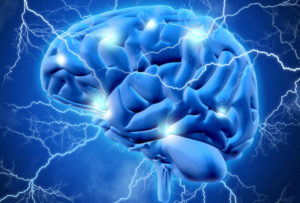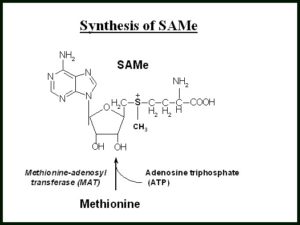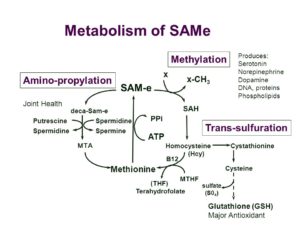 SAM-e, S-adenosyl-L-methionine, is vital to the production of our body’s most important antioxidant, glutathione, as well as the secondary antioxidants, cysteine and taurine. It also enhances the antioxidant power of superoxide dismutase (SOD) These capabilities underscore SAM-e’s importance as a neuroprotective compound, given the extraordinarily high metabolic activity and energy-intensive demands of both brain cells and neurons.
SAM-e, S-adenosyl-L-methionine, is vital to the production of our body’s most important antioxidant, glutathione, as well as the secondary antioxidants, cysteine and taurine. It also enhances the antioxidant power of superoxide dismutase (SOD) These capabilities underscore SAM-e’s importance as a neuroprotective compound, given the extraordinarily high metabolic activity and energy-intensive demands of both brain cells and neurons.According to Dr. Weil,
“In research reported in August, 2010, in the American Journal of Psychiatry, investigators from Harvard Medical School and Massachusetts General Hospital gave either SAMe or a placebo to 73 depressed adults who had not responded to prescribed antidepressant drugs; all continued to take the drugs. After six weeks of treatment, 36 percent of the subjects taking SAMe showed improvement, compared to just 18 percent of the placebo group. Moreover, 26 percent of those in the SAMe group had complete remission of symptoms, compared to just 12 percent in the placebo group. SAMe doesn’t work for everyone, but neither do antidepressant drugs.”
Dr. Brown points out that most Parkinson’s patients have very low SAM-e levels. Levodopa, the most common medication for Parkinson’s, depletes SAM-e and he recommends that it be taken

with levodopa or Sinemet (carbidopa levodopa) . In general, he explains that SAM-e is good for our liver, joints and cartilage as well as the depression that can affect 30% of Parkinson’s patients, so it is a
healthy supplement for most people to take. Side effects are minimal for most people including activation, nausea, mild anxiety and loose stools. The main contraindication is bipolar disease because it can enhance mania.

erately effective for fibromyalgia, good for depression and anxiety, mental cognition and liver detoxification. It was discovered in Italy 4 decades ago. Although SAM-e has only been on the U.S. market since 1999, it has been studied for decades internationally and is approved as a prescription drug in Spain, Italy, Russia and Germany. More than 1 million Europeans have used it, primarily for depression and arthritis.

